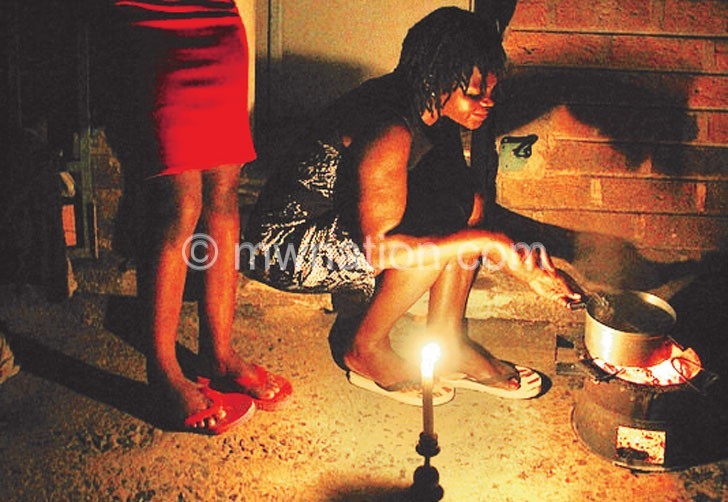Escom eyes power from Mozambique
Haunted by prolonged nationwide power rationing, Electricity Supply Corporation of Malawi (Escom) has turned to Mozambique as an alternative source of energy through an interconnection project set to materialise in 2020.
Escom public relations manager Kitty Chingota, in an e-mailed response to a questionnaire last evening, said the project, expected to be completed in 2020, will involve construction of a 210-kilometre long 400kV power transmission line from Matambo Substation in Tete, Mozambique to Phombeya Substation in Balaka.

She said: “The first phase, which is feasibility study, detailed design and production of tender documents, which is already underway, will take 11 months to May 2017. Thereafter, the tendering process for contractors will take about nine months to a year. Thus, construction is expected to start in mid 2018 and be completed two years later in mid 2020.
“It has to be noted that for the Malawi side, the first phase of the major Interconnecting Substation at Phombeya is already under construction with financing from the MCC [Millennium Challenge Corporation] and will be completed in early 2018, just before the construction of the line gets off the ground.”
According to Chingota, the Norwegian Trust Fund, a fund from the Norwegian Government, but managed by the World Bank, is financing the first phase. She said the second phase, which is the major construction phase, will be funded by a pool of financiers comprising the World Bank as the major financier and KfW [German government-owned development bank], Norwegian Trust Fund and European Investment Bank (EIB) as co-financiers.
She said the estimated cost of the project stands at $140 million (about K105 billion). However, she was quick to add that the actual cost would be confirmed after the ongoing feasibility study and detailed design.
On the significance of the project to the current electricity supply problems facing the country, Chingota said since Malawi’s power system is isolated, it has no immediate fall back plan in terms of supply challenges like is the case at the moment.
She said the interconnection, while being a win-win scenario for both countries, offers the chance to get quick sources of power from others in the region that might have surplus supply and also to be able to sell its own surplus at certain times.
Said Chingota: “It also fosters development of new sources of power in a country with an eye on a bigger and broader market other than just domestic, thereby allowing the country to earn forex through export of power. It would also encourage investors in the power market to come in, since they would see a bigger and broader market that was less risky than a constricted domestic market. Thus the interconnection will help to address the current power challenges in the country through these two ways.”
Escom is currently rationing power to industries and homes with the aim of saving some power. The criteria include other industries operating during non-peak hours and households going at least 10 hours without electricity.
In a post on its Facebook page, Escom expressed excitement that the Mozambique-Malawi Power Interconnection Project has begun.
“We are excited that the Mozambique-Malawi Power Interconnection Project has finally begun. Last week, our engineers were in Mozambique to kick-start the project. They visited Matambo Substation in Tete, which will be the starting point of the 400kV line from Mozambique to Malawi. We will keep you posted on any new developments,” reads the Facebook post.
Commenting on the development in a telephone interview on Tuesday, Malawi Confederation of Chambers of Commerce and Industry (MCCCI) president Karl Chokotho said the “beginning” of the project is a good progress as far as solving the persistent electricity blackouts, since what the business community want is the actual power.
He said: “All these things happening now should have happened ‘yesterday’ if ‘today’s’ predicament was to be avoided and with the pace projects are initiated in the country, it is still years before the actual power is brought to businesses and industries. We are just hoping it will not take another five to 10 years for the actual power to come about.”
The beginning of the interconnection project is coming after its deal was initially rejected by Malawi during former president Bingu wa Mutharika era reportedly due to cost implications.
In 2007, the World Bank approved a $93 million credit for the construction of a power link between Malawi and Mozambique, giving the Southern African neighbours access to reliable and affordable energy.
Mozambique’s share of the credit was $45 million which would have involved the installation of a 135 km 220kV power line from the Matambo substation in Mozambique to Phombeya in Malawi.
On the Malawi side, about 75 km of 220kV transmission line was to be built and a new 220KV substation installed at Phombeya.
Despite being initiated in 2007 by Bingu without Parliament approval, the agreement virtually collapsed after Parliament refused to approve the Loan Authorisation Bill in 2009, arguing the initial costs outweighed the benefits as it would require Malawi to pay $480 000 (almost K156 million at that time’s exchange rate) a month to tap the electricity from Mozambique. The House referred the Bill back to the Budget and Finance Committee for further scrutiny.
Later in 2010, the World Bank cancelled the loan citing that they have waited for too long for the Malawi Parliament to discuss and pass the Authorisation Bill.
However, in 2012, the Joyce Banda administration made a U-turn on the project, arguing the link would assist in resolving the country’s power supply problems.
Even so, nothing much happened since then. The project was then resuscitated in 2013 by Malawi and Mozambique and financing was secured in 2014 from the Norwegian Trust Fund, managed by the World Bank, to prepare the project again for tender.





